LAKE LEELANAU, Mich. — Consumers, and consequently automakers, are increasingly moving away from sedans and into crossovers as drivers seek more space and utility on roads heavily populated by larger and taller vehicles. While the various crossover segments are dominated by bigger, more expensive, family-oriented vehicles, those at the very bottom of the size and price ladder are a little different. The diverse selection of subcompact crossovers are targeting an equally diverse selection of buyers who need something sized to fit into their urban and suburban driving lives — not to mention their budgets. Some sort of active, outdoorsy lifestyle is almost always intended.
Enough of these small crossovers have popped up that we thought it high time to pick some popular competitors — the Honda HR-V, Hyundai Kona, Jeep Renegade and Kia Soul — and pit them against one another in a four-way comparison test. We tried to spec them out as closely as we could in terms of price, with the Jeep standing out as the sole outlier with a price over $30,000. Following in the footsteps of our midsize pickup comparison test, we drove up to Michigan's pinky, where we’d eat, sleep, and breathe these four crossovers to figure out which came out on top based on our 100-point ranking of objective and subjective metrics.
Certainly, there are more choices available than this four (a Subaru Crosstrek in particular was not available at the time of our test), but we think the HR-V, Kona, Renegade and Soul are a representatively diverse collection of popular choices. Without further ado, here are the results of our test, starting with fourth place.
Related:
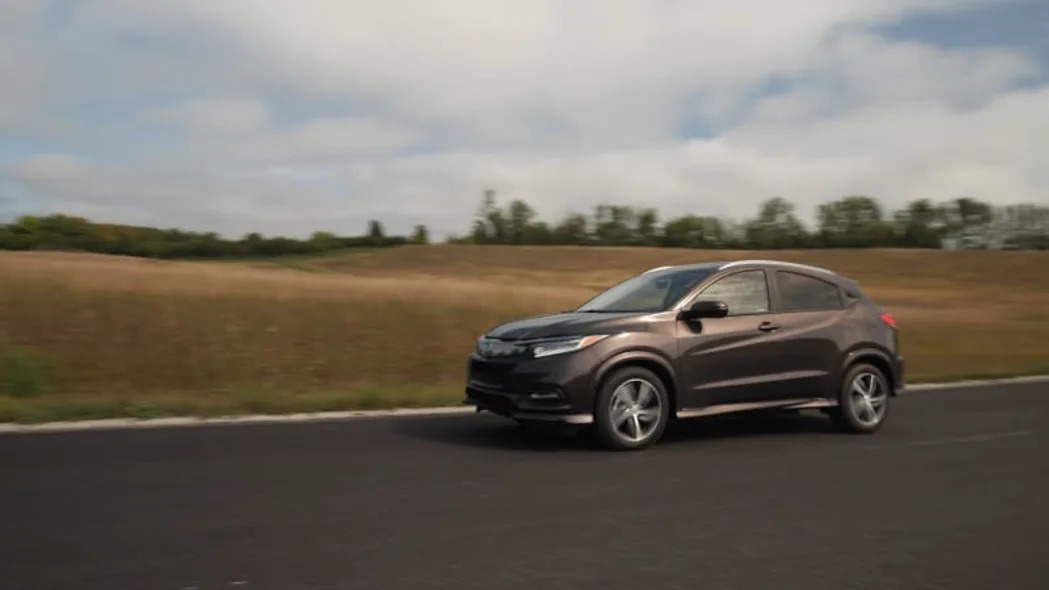
Fourth place: 2019 Honda HR-V AWD Touring – 72.2 points
The Honda HR-V is the second oldest vehicle in this comparative set behind the Jeep Renegade. We first tested it in April 2015. More so than its Jeep counterpart, the Honda feels its age. It’s dated inside and out, the infotainment tech is in dire need of an update (yes, even though it was actually recently updated), and the CVT feels at least a generation behind most others currently available.
And that powertrain is the biggest issue that held the HR-V back from a better score in our comparison. Of the four vehicles, it has the least power, which makes the CVT even more of a nuisance. Its naturally aspirated 1.8-liter engine makes 141 horsepower and 127 pound-feet of torque. Stand on the accelerator as hard as you want, but you’ll still be waiting, and waiting some more, for this thing to reach highway speeds while the CVT keeps the engine groaning at high rpm. Consumer Editor Jeremy Korzeniewski put it well: “If you've ever wondered why people complain so much about CVTs, take the HR-V for a spin.”
That’s not to say the HR-V is without its driving charms, which is why Korzeniewski called it a “frustrating vehicle.” Once up to speed, the HR-V handles well and is happy to keep up the pace through the curves. It’s among the best to steer of the bunch, with the response and balance we’ve come to expect from Honda over the past three decades. We really enjoyed aiming it down the tranquil roads meandering along the Northern Michigan lakeshores and apple orchards. We just knew that if we did have to put on the brakes, it would be a long and loud wait until we could get it back up to an appropriate clip.
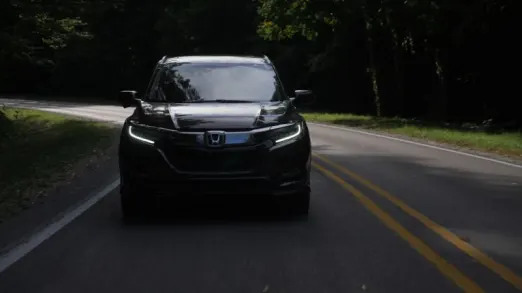
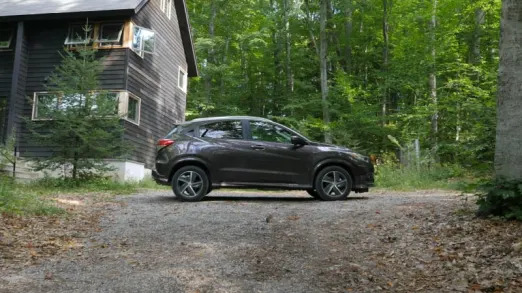
We also like the HR-V’s interior. It’s well thought out, with nice materials and comfortable seating. It offers the most cargo space behind the rear seats, in addition to its second-row “Magic Seat” that features seat cushions that fold upward to provide a large, vertical storage space separate from the rear hatch cargo area. If space and versatility are of paramount concern, the Honda provides a compelling case for itself.
Our biggest gripes inside the HR-V have to do with its ancient infotainment system. It’s not easy to use, with slow responses and low-quality graphics. This is particularly frustrating because Honda could offer something better. “It’s awful,” said Associate Editor Stocksdale. “I can’t believe Honda still puts this in any of its cars, because it has a better infotainment system. The one in the Honda Accord works great,” adding that it's much sharper and easier to use compared to what’s offered in the HR-V.
It feels like the Honda HR-V is an update away from being a top contender. Give it a more potent powertrain and update the multimedia tech, but keep the deft handling and thoughtful interior, and the HR-V would instantly become a much more compelling daily driver.

Third place: 2019 Jeep Renegade Limited 4X4 – 75.1 points
The Jeep Renegade is a crossover that skews further toward the “sport activity” end of the spectrum than anything else in our test. It’s in its DNA, and that's clear as soon as you see its boxy body and seven-slot grille. Its exterior styling is a playful take that splits the difference between the Wrangler and the XJ Cherokee of the 1980s and '90s, which, if you ask most of our editors, is a good thing.
“The Jeep Renegade is mighty stylish with its Wrangler-inspired boxy shape and scowling face,” said Stocksdale. “And with the panoramic sunroof, it feels almost as open as the Wrangler it wants to be.”
This was the most expensive vehicle in our quartet, with a total price of $34,265. Without the huge sunroof, 8.4-inch Uconnect touchscreen, Beats premium audio system, slick LED lighting package and the Safety and Security Group (blind-spot and cross-traffic warning, security alarm and tonneau cover), the Jeep would have come in at $29,390. That would make it $195 less than our Honda HR-V. Note that we used that lower, optionless price when calculating our objective metrics in order to better represent the Renegade's overall value. The finishing order would be the same either way.
Inside, the Jeep is handsome, with a roomy, airy and bright cabin — thanks in part to that $1,595 panoramic sunroof option our tester was equipped with. That went a long way in improving overall comfort as we filled up all five seats with hungry Autobloggers for a not-so-short trip to our dinner spot, despite the fact that the HR-V and Kia Soul boast more rear legroom. The Renegade suffers in cargo space, being the least capacious behind the second row and beating only the Kona in maximum cargo area with the rear seats folded.
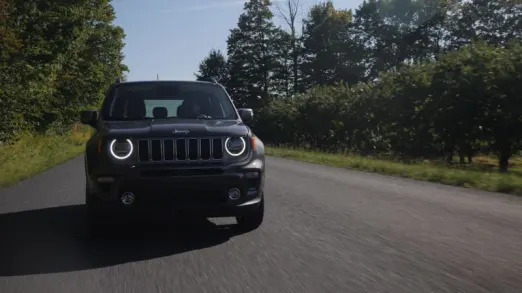
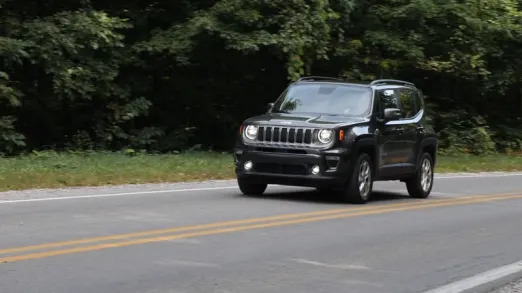
The Renegade’s powertrain is an interesting one, with a turbocharger supplementing just 1.3 liters of displacement and a nine-speed automatic to change gears. Peak output is 177 hp and 210 lb-ft. There’s some lag, but the overall experience is actually kind of fun. “The power delivery reminds me a bit of my early teen years on two-stroke dirtbikes,” mused Korzeniewski. “The elastic rush of torque is kind of like a rubber band that slowly builds tension before finally and suddenly releasing. That never fails to put a smile on my face.”
The Jeep falls apart dynamically as speeds increase on curvy roads, which is no surprise. The tall, boxy ute, with its abundance of clearance, rolls through corners. Its steering is also the vaguest, though we’ll admit that handling will come under a lot more scrutiny from a crew of journalists amidst a comparison test than it will by the customers who buy the Renegade based on any of its other endearing qualities (not to mention its genuinely greater off-road capability).
Jeep fans looking at well-optioned Renegades might want to stroll around the lot a bit. While Editor-in-Chief Greg Migliore opines that the Renegade is the coolest vehicle in this segment, he concedes that its price is a weakness. “I would argue a Cherokee or a Wrangler is a better deal and a more compelling choice, but the Renegade is very nice for what it is. It's just a little expensive.”

Second place: 2019 Hyundai Kona FWD – 78.9 points
The youngest nameplate of the bunch, the Hyundai Kona also appears at first blush to be the most well-rounded. Our front-wheel-drive tester came equipped with a turbocharged, 1.6-liter engine good for 175 hp and 195 lb-ft routed through a 7-speed dual-clutch transmission, which Korzeniewski notes are “perfectly tuned for this application.” With carpeted floor mats ($125) being the only option to speak of, our tester rang in at $28,605, making it the least expensive of the bunch.
The Kona’s unique appearance could be a good thing or bad thing, depending on who you ask. Your author quite likes the stylish crossover with its funky face, though Migliore isn’t so impressed by its “crazy styling,” which includes divisive elements like plastic cladding and split headlights. Korzeniewski agrees, saying, “I don't love the styling, but appreciate that it's at least unique.”
It's quite comfortable inside. We like the materials and style, and the position and supportiveness of its seats. This makes it a worthy companion for long driving stretches. It’s also the most efficient of our small armada, with a combined fuel economy rating of 30 mpg (for reference, the Soul achieves 29 mpg combined, the Honda in AWD guise gets 28 and the Jeep 4x4 gets 26). Easily achievable (and surpassable) fuel economy figures help make the Kona a fine highway warrior.
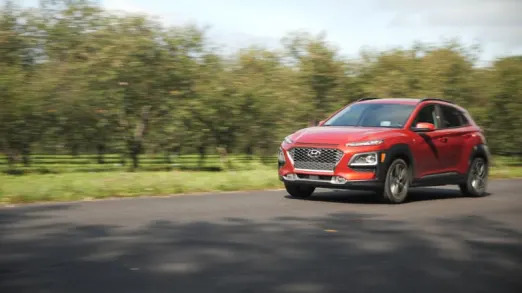
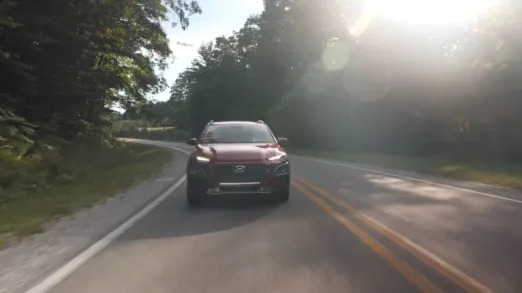
This fighter’s Achilles heel is its interior capacity. It has the least second-row legroom, the second-smallest cargo area and by far the least maximum cargo capacity. Two of our staffers have experience putting child car seats into the Kona and found it to be an unpleasant chore.
If driving dynamics are most important to you, the Kona is the one to get. With excellent handling and ample power on tap, this was the most entertaining to drive, especially if you get a kick out of squealing your front tires away from a stop sign. “This is far and away the driver's choice of this group,” Stocksdale declared. “The turbo engine is punchy, and the chassis is a blast. It responds fast and eagerly to steering inputs, and it's so composed, you discover you can push it harder and harder.” The feel of that steering is also excellent, and it weights up progressively as you dial in more angle.
Summing the Kona up perfectly, Stocksdale added, “It's a joy to drive in a segment known for boring machines.”
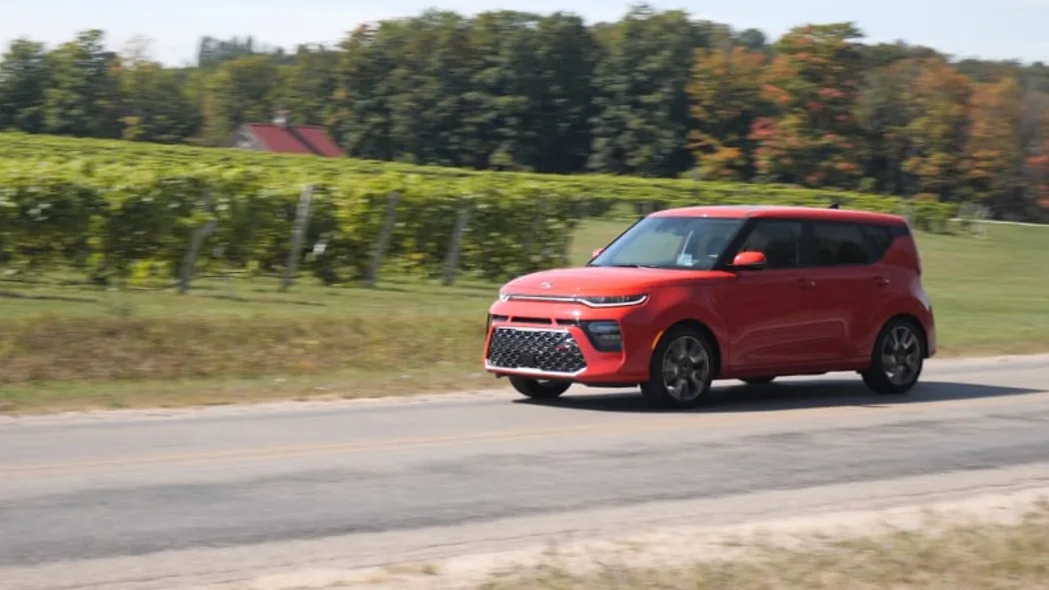
First place: 2020 Kia Soul GT-Line 1.6 Turbo – 82.5 points
This might seem a little weird.
The Kia Soul definitively feels the least like a utility vehicle of all the crossovers represented here. It doesn’t have the off-road genetics of a Jeep, the practical imaginings of the HR-V or the, um, plastic fenders of the Kona. It doesn’t even offer all-wheel drive! Yet the Soul won our subcompact crossover comparison, and not by the squeaky-thin margin that made our midsize pickup comparison so harrowing. The Kia won the whole damn shebang, fair and square.
Before we took these four contenders Up North, we’d have felt weird about it, too, but after putting them through their paces as a group, we’re comfortable with the result.
The Soul may actually outbox the Renegade in terms of styling. As far as performance, it definitely outboxes all contenders. Like the Kona, the Soul is powered by a 1.6-liter turbo paired with a seven-speed DCT, but in this case, the engine is tuned to 201 hp and the same 195 lb-ft.
Though arguably sportier — or at the very least, more powerful — than its Kona cousin, the Soul doesn’t feel quite so composed. Its suspension is a bit on the stiff side — which does serve to provide the driver a good sense of what’s going on between tires and tarmac — but it lacks the corner-carving poise of the Hyundai or the Honda. The steering feel is light and effortless, but the response is a bit twitchy. It’s still a hoot to drive, with far more lateral stability than the Renegade.

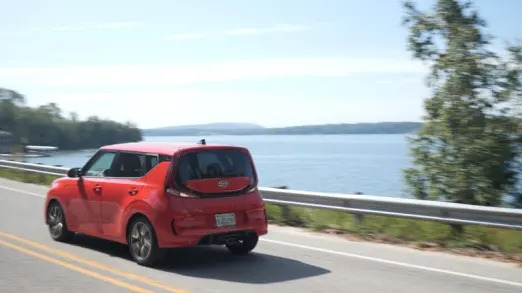
We can’t talk about Soul without talking about the styling, and it’s impossible to do so without using the word “funky.” Where far-out boxes like the Scion xB and Nissan Cube tried to capture the imagination of young drivers, they ultimately failed where the Soul, as its continued existence testifies, prevailed. And today’s Soul looks better than ever. The signature lighting tucked beneath the length of the hood, the way the mostly vertical taillights angle around the rear window, the macho grille and the centrally mounted twin tailpipes all add up to a Soul that stands out without hurting the eyes.
Inside, it retains some of that same hipness without being quite as brazen. The big story is its spaciousness. At first glance, the cargo area looks roomy, and that’s before you realize that significantly more depth is available after removing a divider. There’s almost as much max cargo volume as the Honda, and significantly more than the Kona or Renegade. Rear seat legroom is only a tad smaller than the leading HR-V as well. No matter how you look at the interior — for the driver, passengers or their cargo — the Soul has got serious space.
Despite being the second-least-expensive vehicle in our test — and cheapest overall by base price — the Soul came well equipped. Standard GT-Line equipment includes adaptive cruise control, a beautiful 10.25-inch touchscreen display, head-up display, Harman-Kardon premium audio system, wireless phone charging, heated leatherette front seats and a heated leather-wrapped flat-bottom steering wheel for $28,485. Our tester’s only add-ons were carpeted floor mats ($130) and a cargo tray ($95), bringing the total to $28,710.
Not offering all-wheel drive may be a deal-breaker for some (and if it is, check out the runner-up Kona), but all of these other models are offered with front-wheel drive for a reason — for many buyers, the higher cost and lower fuel efficiency aren't worth it, especially if you live in a warmer climate. And even if you don't, a Soul with proper tires will be more than capable of tackling some rain and light snow.
In the end, the Soul simply manages to do a number of things — crossover-specific or otherwise — as good as or even better than everything else on this list. Sure it might be a little harder to define than the rest, but as Migliore so succinctly put it, “It may not offer all-wheel drive, but the Kia Soul seems like the ideal blend of everything else. It has distinct, funky styling, a cavernous interior, a powerful engine, and it's not totally dull to drive.”
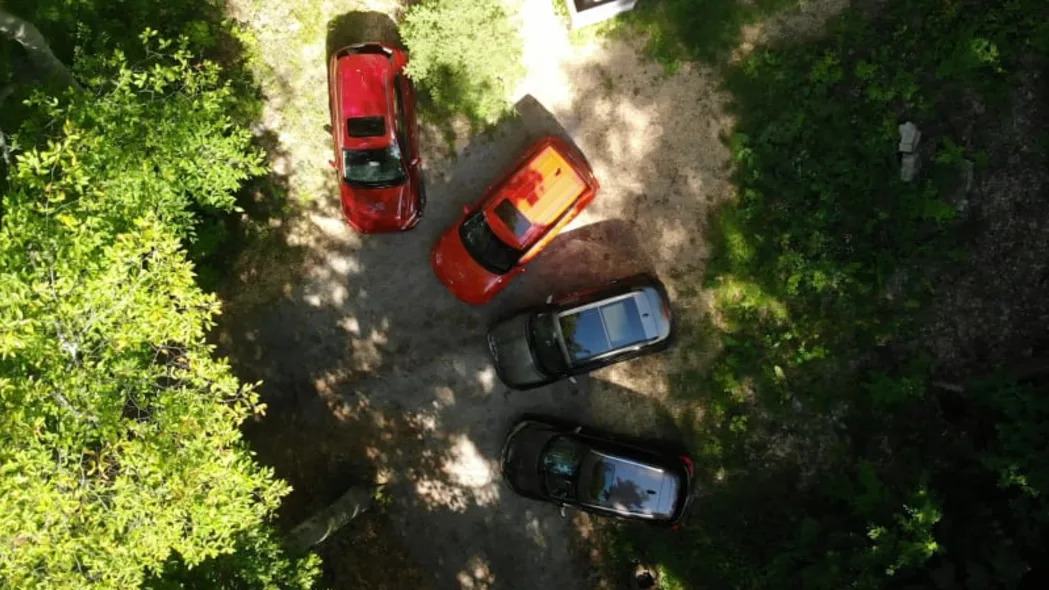
Final thoughts
This was such an interesting comparison. The subcompact crossover segment is relatively young but quickly expanding, and it’s one that’s hard to pin down. There are more to choose from than the four vehicles we tested here, and our results don’t necessarily mean you should pick our winner, the Kia Soul, over the rest (except maybe the Honda). If you don’t see its pint-sized rear seat and cargo area as major problems, the Kona could serve you just as well, or better if you feel like you need all-wheel drive. The Jeep carries its own share of style and swagger that will certainly serve certain buyers — particularly those who actually plan to venture off pavement.
We’ll keep doing tests like this, and in the meantime we’ll continue to review the other compelling models in the segment, like the Subaru Crosstrek, Mazda CX-3 and CX-30 and Nissan Rogue Sport. Heck, the electrified subsegment is getting competitive too, with EV versions of the Soul and Kona on their way to join the excellent Kia Niro.
Compared to its competition, Kia has had a lot of time to perfect the Soul, and this test result stands testament to that. In fact, Kia has consistently offered customers an ever-increasing blend of refinement, performance, content and value across its range of vehicles. The Soul may not be the most traditional crossover in the subcompact field, but after this test, we think that’s for the best.
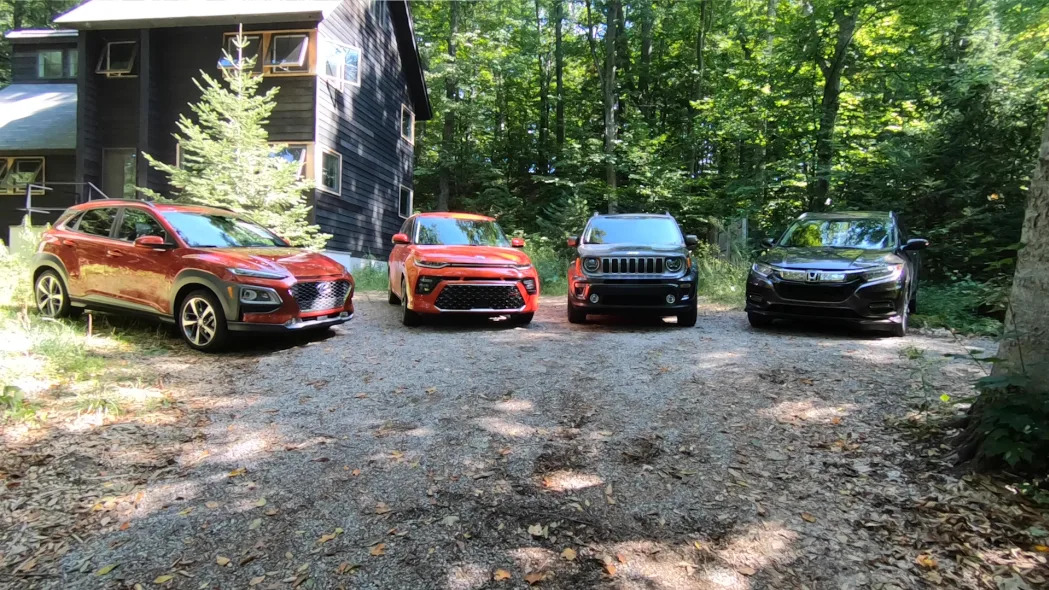

Sign in to post
Please sign in to leave a comment.
Continue